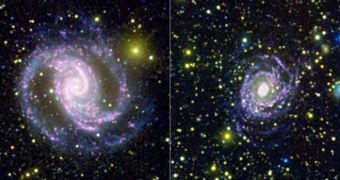Over decades of astronomical observations, experts from around the world have determined that the ratio of small to large stars in the Universe is fixed. They have defined smaller stars as being as large as our Sun or smaller, while larger stars are 20 times or more the mass of the Sun. They have believed that, for every massive star, there had to be about 500 smaller ones, and this ratio was the basis for the theory, and for understanding the mechanisms of stellar production throughout the Cosmos. Now, new data from the NASA Galaxy Evolution Explorer turns this theory on its head.
The ultraviolet telescope has managed to determine that, in fact, much more smaller stars are formed than the theory holds, which means that the entire model is erroneous. The differences are quite significant too. In some galaxies, the stellar ratio was determined to be of 2,000 smaller stars for each massive one. The reason why the smaller ones were not observed earlier resided in the fact that they were located around the larger ones at times, which means that their light was masked by the others' glow, ScienceDaily reports.
“What this paper is showing is that some of the standard assumptions that we've had – that the brightest stars tell you about the whole population of stars – this doesn't seem to work, at least not in a constant way,” the principal investigator on the new study, Johns Hopkins University research scientist Gerhardt R. Meurer, says. Details of the investigation appear in the April 10th issue of the Astrophysical Journal.
The problem raised by the new data is that some of the properties established for a large number of galaxies around us may be erroneous. The researchers compare this situation to trying to assess the number of Earth inhabitants at night, by looking at lights. Some areas will be severely underestimated because of electricity restrains, and the statistic will be flawed. It's the same with assessing the mass of a galaxy, for example. If many small stars remain invisible and are overlooked, the total mass will be vastly underestimated.
“Especially in these galaxies that seem small and piddling, there can be a lot more mass in lower mass stars than we had previously expected from what we could see from the brightest, youngest stars. But we can now reduce these errors using satellites like the Galaxy Evolution Explorer,” Meurer adds.

 14 DAY TRIAL //
14 DAY TRIAL //